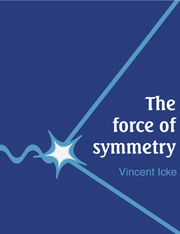Book contents
- Frontmatter
- Contents
- Preface
- Introduction
- 1 A matter of force
- 2 Stalking the wild rainbow
- 3 Light
- 4 Maybe I'm Heisenberg
- 5 Catch a falling quantum
- 6 Quantum beanbags
- 7 Symmetries
- 8 Quantum relativity: nothing is relative
- 9 Life, the Universe and everything
- 10 The physics of a tablecloth
- 11 Colour me red, green and blue
- 12 Smashing symmetry
- 13 How much is infinity minus infinity?
- 14 Excelsior! The ascent to SU(∞)
- A modest reading proposal
- References
- Glossary
- Index
5 - Catch a falling quantum
Published online by Cambridge University Press: 05 August 2012
- Frontmatter
- Contents
- Preface
- Introduction
- 1 A matter of force
- 2 Stalking the wild rainbow
- 3 Light
- 4 Maybe I'm Heisenberg
- 5 Catch a falling quantum
- 6 Quantum beanbags
- 7 Symmetries
- 8 Quantum relativity: nothing is relative
- 9 Life, the Universe and everything
- 10 The physics of a tablecloth
- 11 Colour me red, green and blue
- 12 Smashing symmetry
- 13 How much is infinity minus infinity?
- 14 Excelsior! The ascent to SU(∞)
- A modest reading proposal
- References
- Glossary
- Index
Summary
An experiment with electrons
The preceding chapters described the quantum behaviour of Nature in a general way. In order to show quantum uncertainty at work, it is useful to look at an actual experiment in detail. This demonstrates the practical consequences of the particle–wave duality. To keep things uncluttered, the experiment is only an idealized example, but it will serve to show when quantum interference occurs (wave behaviour) and when it does not (particle behaviour). I will try to demonstrate the intimate connection between the properties of waves and linear superposition, and the consequent uncertainty in the motion of quanta.
For once I will try to be precise, so this exposition will be rather more technical than elsewhere. Those who wish to do so, may skip to Chapter 6 without much damage to their education. Before we begin, let me repeat the warning about the generality of analyses such as the one to be given here: I speak about ‘experiments’ or ‘observations’ only in order to make a connection with what a real person could do in a real laboratory, and not because the particle–wave duality is only a laboratory phenomenon that requires a conscious observer. Even though an electron does not wear a lab coat, it is subject to the uncertainty relations when it ‘observes’ other quanta.
- Type
- Chapter
- Information
- The Force of Symmetry , pp. 69 - 79Publisher: Cambridge University PressPrint publication year: 1995



